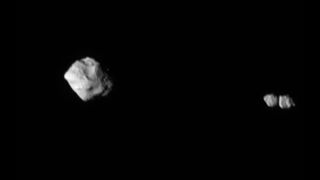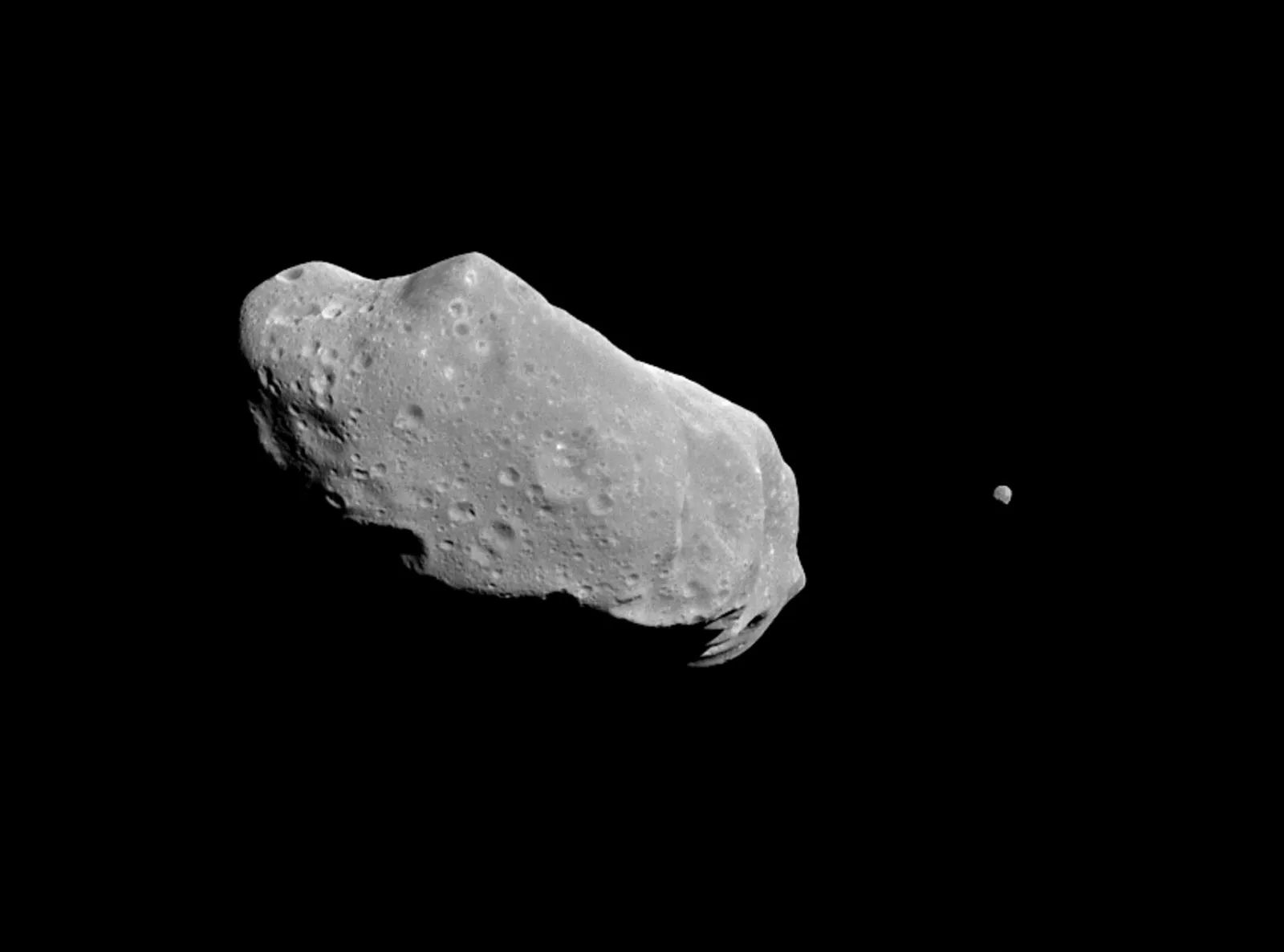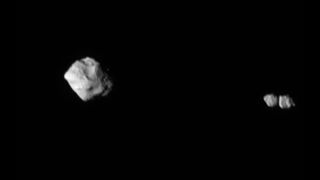Mind-Blowing Lunar Encounter: NASA Discovers Asteroid with its Own Tiny Moon!
In a recent expedition NASA's Lucy spacecraft had an unexpected encounter with a small asteroid called Dinkinesh. This cosmic rendezvous unveiled a remarkable secret: the asteroid has its very own mini moon!
During Wednesday's flyby the spacecraft located 270 miles away from Dinkinesh in the main asteroid belt beyond Mars captured an astounding image of the celestial pair. Scientists were thrilled to confirm that Dinkinesh measures a mere half-mile in diameter while its tiny companion is just one-tenth of that size.
This discovery holds immense significance as it serves as a practice run for Lucy's upcoming mission to explore larger enigmatic asteroids near Jupiter. Launched in 2021 Lucy is scheduled to reach the first of these Trojan asteroids in 2027 and conduct research for a minimum of six years. Interestingly the original goal of visiting seven asteroids has now expanded to include a total of eleven.

The name "Dinkinesh" has a meaningful origin. It translates to "you are marvelous" in the Amharic language of Ethiopia. The same term is used to refer to Lucy a 32-million-year-old hominid fossil discovered in Ethiopia in the 1970s after which the spacecraft is named. Scientists were delighted to find that Dinkinesh truly lived up to its name as expressed by Hal Levison the lead scientist from the Southwest Research Institute.
While this remarkable encounter may seem extraordinary it is not entirely surprising. NASA's Lucy mission is designed to unravel the mysteries of our solar system's ancient past by studying Trojan asteroids. These asteroids are remote celestial bodies that share the same orbit as Jupiter circling around the Sun at the same distance as the gas giant itself. By examining these asteroids scientists hope to gain insights into the origins and evolution of our solar system.
As the Lucy spacecraft embarks on this mission researchers anticipate uncovering valuable information about these Trojan asteroids' composition structure and history. This data will enhance our understanding of the early solar system and shed light on the formation of planets. The discovery of Dinkinesh's tiny moon adds another layer of intrigue demonstrating the captivating diversity and surprises found in space.
The mini moon accompanying Dinkinesh poses exciting questions for scientists to explore. How did it form? What are its characteristics? What role might it have played in the asteroid's evolution? Experts anticipate that analyzing this fascinating celestial duo will unveil fascinating insights into the dynamics of asteroids and their moons.

By capturing images and collecting data during its upcoming encounters with Trojan asteroids Lucy will provide scientists with a wealth of information to answer these inquiries. The mission will contribute to our understanding of the enigmatic bodies that populate our solar system pushing the boundaries of knowledge and paving the way for future space exploration endeavors.
Our solar system an intricate web of celestial bodies has remained an enigma to humanity for centuries. The discovery of Dinkinesh's miniature moon is just the latest chapter in our quest to unravel the secrets of the cosmos. Throughout history space exploration has captivated our imaginations inspiring astronomers and scientists to gaze into the night sky with wonder and curiosity.
The exploration of space has come a long way since the first satellite Sputnik was launched into orbit in 1957. Over the years humanity has achieved numerous milestones including landing the first humans on the moon and sending spacecraft to explore neighboring planets. These achievements have expanded our knowledge and deepened our understanding of the universe we inhabit.
NASA the National Aeronautics and Space Administration has been at the forefront of these endeavors. With its dedicated team of scientists engineers and astronauts the agency has pushed the boundaries of space exploration constantly seeking answers to the many mysteries that surround us.
The Lucy spacecraft represents the latest addition to NASA's impressive fleet of missions. Named after the renowned fossil "Lucy" this spacecraft aims to uncover the secrets of Trojan asteroids. These ancient celestial rocks residing in the vicinity of Jupiter hold valuable information about the early stages of our solar system.
What makes these Trojan asteroids unique is their shared orbit with Jupiter. Just like a cosmic dance these asteroids gracefully follow the path of the largest planet in our solar system circling the Sun at the same distance. This synchronized motion has kept the Trojans in place for billions of years making them a valuable source of knowledge about our solar system's past.
Throughout its journey Lucy will encounter a series of Trojan asteroids each offering a glimpse into the history of our cosmic neighborhood. By studying their composition structure and history scientists hope to find clues about the processes that led to the formation of planets and the shaping of our solar system.
However before reaching its final destination Lucy had a fortuitous encounter with the small asteroid Dinkinesh. The serendipitous discovery of a tiny moon orbiting Dinkinesh added an unexpected twist to the mission. This unexpected finding delighted scientists and opened new avenues for research.
As scientists examine the images captured during the flyby they are left with a sense of wonder and a multitude of questions. How did this mini moon come to be? What are its unique characteristics? What role has it played in the evolution of the asteroid? The mini moon represents a puzzle waiting to be solved providing scientists with yet another captivating aspect to explore.
The discovery of Dinkinesh's tiny moon also serves as a reminder of the astonishing diversity of celestial bodies in our solar system. From the majestic gas giants to the rocky smaller asteroids our cosmic neighborhood is filled with surprises at every turn. Each new expedition and encounter brings the potential for groundbreaking discoveries contributing to our ongoing understanding of the universe.
The exploration of space not only expands our knowledge but also challenges our imagination. It is a testament to the remarkable achievements that humanity is capable of when driven by curiosity and the desire to explore the unknown. Every step we take in our cosmic journey brings us closer to answering fundamental questions about our existence and the origins of our universe.

As NASA's Lucy spacecraft continues its mission more exciting discoveries are on the horizon. The images and data collected from each encounter will help unravel the mysteries surrounding Trojan asteroids shedding light on the early stages of our solar system's formation. This knowledge will not only deepen our understanding of our cosmic origins but also inform future space exploration endeavors.
The story of Dinkinesh and its tiny moon is just one chapter in the ongoing saga of space exploration. With each new mission scientists and astronomers push the boundaries of knowledge uncovering secrets that have been hidden for billions of years. The Universe presents us with an infinite tapestry of wonders and it is our collective responsibility to continue exploring learning and marveling at the vastness of it all.
In conclusion NASA's Lucy spacecraft during its encounter with the asteroid Dinkinesh has stumbled upon a captivating surprise: an asteroid with a tiny moon of its own. This unexpected finding brings immense excitement and sets the stage for Lucy's forthcoming mission to explore the mysteries of Trojan asteroids near Jupiter. As the spacecraft delves deeper into our solar system's history we can anticipate remarkable revelations that will undoubtedly ignite our curiosity and expand our understanding of the universe we inhabit. Exciting times lie ahead as we continue to unravel the cosmic wonders around us.










